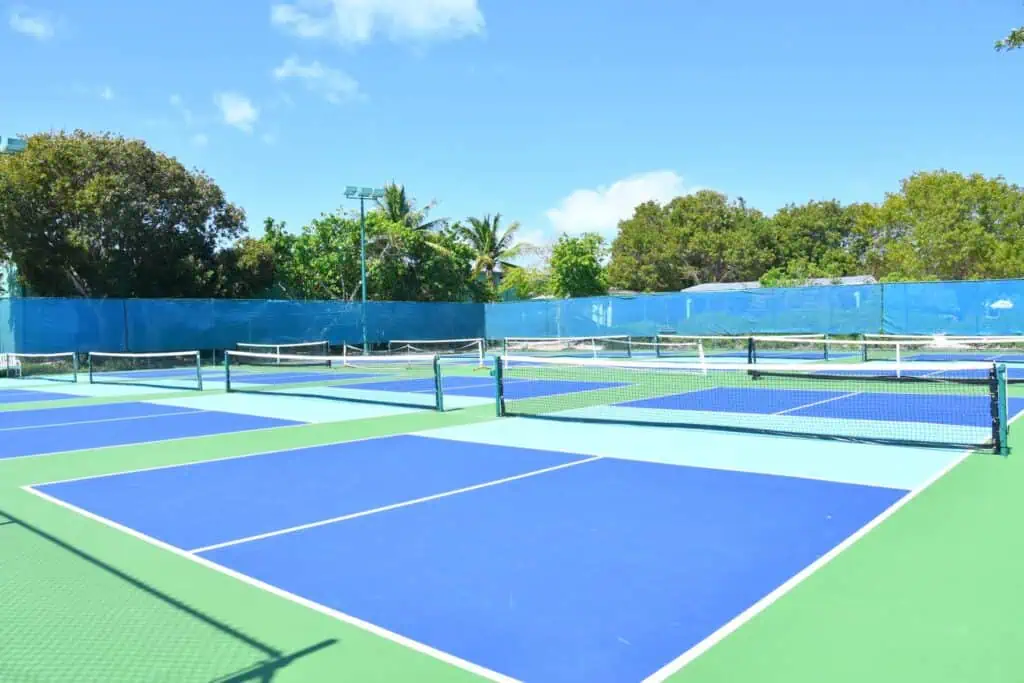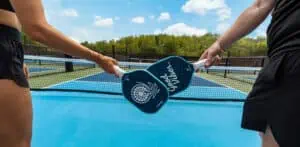Pickleball
Pickleball Court Dimensions Explained: The Essential Layout and Size

Pickleball has quickly evolved from a backyard pastime into one of the fastest-growing sports in America. If you’ve ever watched a game or participated yourself, you probably noticed how the unique dimensions of the court set it apart from other racquet sports. Understanding these dimensions is key for both players and enthusiasts alike, as they shape gameplay and strategies in ways that make this sport so enjoyable. In this article, we’ll break down the essential layout and size of a standard pickleball court, revealing how its thoughtful design promotes an engaging experience for players of all ages and skill levels. Let’s dive into the specifics!
A standard pickleball court measures 44 feet long and 20 feet wide for doubles matches, with a net height of 36 inches at the sidelines that drops to 34 inches in the center. Each court is divided into service areas and includes a 7-foot non-volley zone, commonly known as “the kitchen,” ensuring proper gameplay and strategy.
Pickleball Court Layout and Design
A standard pickleball court, measuring 44 feet long and 20 feet wide, is relatively compact when compared to tennis or other racquet sports courts. This unique size allows for fast-paced action and easy accessibility, making it ideal for both singles and doubles play. As you step onto the court, you’ll notice that the overall design accommodates various play styles while maintaining simplicity—perfect for players of all skill levels.
Each court is cleverly divided into two equal halves by a centerline, with right and left service courts on either side. This division helps players understand where to serve and receive the ball during a game. Knowing which service area you are in can impact your strategy, particularly during competitive matches. For instance, serving from one side may favor certain angles or shots advantageous based on your playing style or opponent’s weaknesses.
The non-volley zone, or “the kitchen,” is another vital element of the court’s design. This 7-foot area extends from the net on both sides, acting as a buffer that prevents players from volleying within it. This rule encourages strategic shot placement and keeps the game dynamic, pushing players to think about their positioning and shot selection more carefully.
To keep up with safety standards and enhance gameplay, a minimum of 10 feet of unobstructed space should surround each side of the court, along with 20 feet at each end. This spacing allows for safe movement during play, ensuring that players have enough room to maneuver without bumping into walls or other obstructions.
When constructing or converting a space into a pickleball court, it’s essential to consider the surface material as well. Ideally, courts should be built with a smooth, non-slip surface like asphalt or concrete, facilitating comfortable play while minimizing injury risk. Think of the joy of gliding effortlessly on a well-maintained surface compared to struggling on uneven ground—it significantly enhances the playing experience!
Understanding these elements—dimensions, design, and safety considerations—truly enriches your appreciation for pickleball. As you prepare to hit the courts yourself, whether at home or with a specially organized getaway through platforms like VibeGetaways specializing in pickleball vacations, remember that each detail plays its role in shaping a great game day.
Having explored the fundamental elements that form a pickleball court’s foundation, let’s take a closer look at how exactly these dimensions translate into gameplay experience and strategy.
Detailed Dimensions: Length and Width
A standard pickleball court has precise dimensions that any player or enthusiast should be familiar with. The total length of the court measures 44 feet (or 13.41 meters) from baseline to baseline, while the width is set at 20 feet (or 6.10 meters). This layout creates a playing area similar in size to a doubles badminton court but distinctly smaller than a traditional tennis court, which typically measures 78 feet long and 36 feet wide. The choice of these dimensions contributes to the dynamic pacing and engaging nature of pickleball, making the game suitable for players of all ages and skill levels.
Each side of the net has designated service areas, measuring 15 feet (or 4.57 meters) deep, where players must serve from. Additionally, there’s the non-volley zone, often referred to as “the kitchen,” which extends 7 feet (or 2.13 meters) from the net on both sides. Understanding this area is crucial because it prohibits players from hitting volleys while standing in that zone, thereby introducing strategic elements to the game.
This multifaceted play area draws players into quick exchanges and strategic plays—ideal for social games yet competitive enough for seasoned athletes.
Keeping in mind these measurements aids in maintaining safety around the court. It is recommended to have at least 5 to 7 feet of clear space surrounding the pickleball court, ensuring players can move freely without risk of injury or obstruction while attempting shots. This extra margin not only fosters an enjoyable gameplay experience but also accommodates spectators and nearby players.
For those considering building their own court—whether it’s for personal use or a community facility—familiarity with these dimensions ensures proper execution during construction and organization of play. By adhering to these standards, you can create a perfect environment tailored for both casual fun and competitive tournaments.
| Measurement | Feet | Meters |
| Court Length | 44 | 13.41 |
| Court Width | 20 | 6.10 |
| Non-Volley Zone | 7 | 2.13 |
| Service Court | 15 | 4.57 |
Knowing the detailed dimensions of a pickleball court is vital for maximizing enjoyment of the game while ensuring safety and facilitating effective play strategies.
As we transition from understanding dimensions, let’s explore the essential markings that define how the game is played.
Key Court Markings
The markings play a vital role in defining the functional areas of the court. Each line has a specific purpose, so getting familiar with them can significantly enhance your gameplay strategy.
1. Baselines
The baselines are perhaps the most crucial lines on the court. They mark the farthest boundaries at both ends, measuring 20 feet wide, reminding players of where they can place their shots. Whenever a player steps over these lines while serving or returning a shot, it’s called a fault.
2. Sidelines
Next come the sidelines, which extend the length of the court to delineate in-bounds versus out-of-bounds areas. These lines help players gauge whether a shot has remained within play; if any part of the ball touches outside this boundary, it’s considered out, adding extra pressure during intense rallies.
3. Centerline
Moving on, we have the centerline. This critical line runs perpendicular to the net and divides the service area into left and right sections. When serving, players must aim to get their ball into one of these compartments, adding a strategic layer to service plays since serving into a player’s less dominant side can be advantageous.
4. Non-Volley Line
Finally, there’s the non-volley line, also known as the kitchen line. It runs parallel to the net and defines the boundary for players looking to smash volleys. You cannot step into this area to hit a ball unless it has first bounced on your side; hovering near this line can lead to exciting moments but requires calculated risk-taking.
With these markings established clearly on the court, let’s explore how they interact with the layout and move on to examine critical details about the net’s specifications and positioning within this framework.
Net Height and Placement
Understanding the dimensions and position of the pickleball net is crucial for ensuring balanced and fair play. The net itself should be set at 36 inches high at the sidelines while drooping slightly to a height of 34 inches in the center. This unique dip isn’t just for aesthetics; it influences gameplay by affecting how players serve and return balls, creating an engaging challenge for both beginners and seasoned players.
It’s fascinating to think how such a small variation in height can have a big impact on the dynamics of the game.
The net should always be placed directly in the center of the court, dividing it into two equal halves. Proper positioning not only abides by official regulations but also helps players gauge their strategy as they engage with opponents. The posts that hold up the net are typically spaced 22 feet apart—the exact width of the court—ensuring that everything is correctly proportioned. Moreover, a tightly secured net prevents sagging, which can alter its height during play and confuse players about their shooting targets.
High-quality nets like the ONIX Portable Pickleball Net are specifically designed to adhere to these guidelines. Not only do they meet regulation sizes, but they also offer benefits like portability for easy setup at parks or even in driveways. What sets them apart is their feature-rich construction, including stabilizer legs for safety and internal locking mechanisms for height adjustment. These thoughtful details ensure that whether you’re having a casual game with friends or participating in competitive tournaments, you can rely on a consistently good experience on the court.
When installing your net, check for proper tension; if it sags, it won’t perform correctly. A rule of thumb is to adjust it so that it remains tight during play yet can still handle occasional bumps from errant balls or enthusiastic players.
Keeping accurate measurements and following placement guidelines enhances not just gameplay but the entire pickleball experience. Next, we will explore various types of surfaces suitable for these layouts, ensuring optimal performance on the court.
Standard Court Surface Materials
The type of surface material you choose for a pickleball court can significantly influence not only the playing experience but also long-term maintenance and comfort for players.
Let’s explore some common materials and what makes each unique.
For instance, concrete is one of the most popular choices due to its durability and low maintenance needs. It’s a robust option that withstands weather conditions remarkably well, but there is a trade-off. Over time, the hard nature of concrete can lead to strain on players’ joints, especially during long games or tournaments. Players might enjoy fast-paced action on concrete, but they should also consider suitable footwear with cushioning to mitigate joint stress.
Moving on from concrete, we find another worthy contender: asphalt.
Asphalt provides a good traction surface that many players appreciate; however, it has a shorter lifespan than concrete and can wear down more quickly with heavy use. It’s often favored for outdoor courts because it performs well in various weather conditions. Yet, it requires timely maintenance to prevent cracking and deterioration, which becomes crucial after tough seasons. Regular resurfacing may be necessary to uphold playability over time.
If comfort tops your priority list, consider the next option: artificial grass.
Artificial grass might be just what you’re looking for if you’re aiming for that softer feel underfoot. This material is particularly forgiving on players’ joints and is perfect for high-traffic areas where players are more likely to spend long periods on the court. The downside is that it demands more upkeep than harder surfaces; keeping it clean and free from debris is vital for optimal performance. Additionally, ensure proper drainage so that water doesn’t pool on the surface after rainfall.
Then there’s an engaging option: rubber sports tiles.
Rubber sports tiles offer exceptional cushioning and grip, making them ideal for both recreational play and serious competition. They provide excellent shock absorption and allow for quicker lateral movements without the risk of slipping; however, this quality comes at a price—specifically in terms of initial investments. If the budget allows, rubber tiles can create an unparalleled playing surface that pays dividends in comfort and safety.
While aesthetics matter—choosing light colors like light blue or green can enhance visibility—functionality must remain paramount to craft a court that optimizes both enjoyment and performance.
When considering these options, you’ll want to prioritize factors such as local climate, usage patterns, and your commitment to maintenance before moving forward with any construction plans.
Considerations for Building a Court
Location is the first and perhaps most influential factor. Selecting a flat area is crucial; uneven ground can lead to unpredictable bounces and potential injuries. Moreover, it’s recommended to have at least 5 feet of clearance around all sides of the court. This space isn’t just about comfort; it provides safety by allowing players room to maneuver without running into walls or hard surfaces.
Once you’ve settled on a location, consider the orientation of your court.
Aligning the court north to south is often the best practice. This alignment minimizes the impact of sun glare during play. Nobody wants to squint against the sun while trying to serve or return a fast-moving ball! Proper placement can enhance gameplay significantly, ensuring everyone can enjoy matches without discomfort.
After settling on the location and orientation, it’s vital to dive into legalities next.
Every aspiring court builder should check local zoning laws. Regulations vary by region, and obtaining necessary permits is vital for compliance—and peace of mind. This step may seem tedious, but it prevents any future legal hassles or unexpected costs associated with non-compliance.
Now, let’s illuminate your newly planned court with the right lighting choices.
If you envision enjoying your court beyond daylight hours, investing in high-quality LED lights is key. While these lights are energy-efficient and offer excellent visibility, they require careful installation so as not to glare into players’ eyes. A well-lit court can transform evening matches into enjoyable social gatherings.
Keep in mind that each of these considerations contributes directly to both the cost and usability of your court.
By evaluating aspects like location, orientation, permits, and lighting carefully, you’ll create an inviting space for play while ensuring a safe environment tailored for pickleball enthusiasts. Overlooking any detail could affect your investment in this experienced design!
To take your passion further, consider traveling to premier pickleball facilities that meet all these specifications. With our Vacation Planning Service, you can explore exceptional resorts where pickleball and relaxation go hand-in-hand, making every trip an exhilarating blend of sport and leisure amidst breathtaking surroundings. Call us at 262-891-4768 now!
More Articles
Pickleball: The Perfect Family Vacation Activity for Outdoor Fun and Bonding
Looking for a fun way to get the whole family outside and active on your next vacation? Pickleball might be…
Read MorePickleball History and Popularity: From Backyard Roots to a Global Sport
Pickleball started as a simple way for friends and family to have fun together, but today it’s become much more…
Read MoreVacation Planning Tips & Tricks: Your Ultimate Holiday Checklist for 2025
Planning a vacation might seem as simple as booking a flight and packing a bag, but anyone who’s ever felt…
Read More5 Secrets to Stress-Free Vacation Planning: The Ultimate Guide to Easy Travel
Planning a vacation should be exciting, not stressful, but all too often it feels like a juggling act, with flights,…
Read More


